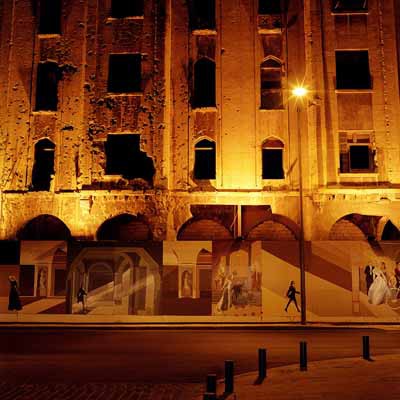 Greta Torossian, Boxes in ”Beirut 99: Real Visions”, 1999. c-print, 39 x 39 in
Greta Torossian, Boxes in ”Beirut 99: Real Visions”, 1999. c-print, 39 x 39 in
Armenians have had a complex relationship with the Arab world, especially in Lebanon. Remnants of Aghed the Catastrophe of 1895-1923 [i], meandered there in waves, reconstituting their lost cities over the new geography of a country yet to be born.
The more affluent settled in the francophone center of Beirut, where many of the prominent political and cultural leaders from the very short lived first republic of Armenia found refuge. The crime of genocide was not yet codified in the annals of international law, even if the intent was there.
The country’s post colonial confessional system of power sharing, its more liberal outlook, and the relative size of its population afforded the Armenian community rights and political clout existing nowhere else in the diaspora. With those opportunities, Armenians prospered and revived their political aspirations, literature, theater, music, visual arts, sports, and spiritual life.
While Armenians played an important role in the arts and cultural life in Lebanon, their relationship with art remained mainly focused on aesthetic ideals. They rarely turned the focus on themselves, even when the subject matter had to deal with their own plight. While he never lived in Lebanon, but widely read there, the author of “Remnants”, the prolific writer and literary critic, Hagop Oshagan [ii] , stopped short finishing his novel when he arrived at the subject of Deportation fearing that the very act of writing would claim his life.
Then there is Levon Shant [iii], a preeminent political leader, intellectual, educator, playwright, and novelist, who urged that Aghed should never be a subject of art, or aestheticized in any form. While it is hard to generalize or quantify the impact of such a statement on his contemporaries, it certainly could have had an effect on cultural institutions and publications.
In the late sixties and early seventies however, parallel with the European and American student discontent, a new generation of Lebanese started questioning their own societal norms. It wasn’t different for the Armenians. While recognition of the crime was entering the legal realm, and becoming increasingly politicized, artists and writers shifted the attention towards their own community and its woes. It was then that art, especially theater, “Metterin Yerku [iv]” “Ara and Arshag [v]”come to mind, started intervening and problematizing its social and cultural norms, finding its rightful place in identities and their formation, while angering the elders.
Crosstalk between Armenian and Arabic was sporadic and haphazard at best. I was happily surprised when a few years ago I came across Krikor Chahinian’s ‘Ahegan [vi]’ series, where not only Arabic poetry was published, but there were translations of works in both directions.
I am, however, a third generation Lebanese Armenian reluctant to speak Arabic, let alone think or write with it.
Things were at their most active and creative in 1975 when the civil war broke out, and all the promising movements came to an abrupt halt, resulting in artists and intellectuals seeking safer harbors abroad. The epicenter had dissolved and could never reconstitute, even within extremely wealthy and privileged communities, such as the United States, surrounded with world class art and educational institutions. Settled in the vicinity of Hollywood, for reasons unknown, the Western Armenian language, that had regained its footing and had come of age in Lebanon, is now officially on the United Nation’s endangered languages list.
Almost 40 years later, the subject of the Lebanese civil war has not been addressed in any meaningful way by Armenian artists of Lebanese descent.
The independence of the state of Armenia after the fall the of the Soviet Union shifted attention from Lebanon, and caused the reconfiguration of the diasporean identity, further removing the repercussions of the Lebanese civil war from the front pages.
While as a subject it has been addressed by such important poets as Vahe Oshagan in Ahazank, (Alarm) [vii](1981), and Krikor Beldian in “ Topography for a destroyed city, illustrated by Assadour [viii], all three having did not do so from personal experience, but through hearsay or from mediated sources.
The only artist that I’m aware of who has dealt with the subject is Seta Manougian, who stayed in the country and lived out the daily-ness of the war. At the present, she leads a secluded life as a buddhist nun in Los Angeles.
I believe a disclaimer is in order here. The timeline in this editorial, the events and the reactions, while accepted and agreed upon by most, cannot be considered historic. No archives exist, nor any scholarly research has been done, no macro or micro histories written with the exception of Seta Dadoyan’s “The Lebanese – Armenian Painting” with the subheading “In Light of Identity Crisis.”[ix]
In the beginning of this article, I separated Aghed and genocide. Aghed in capital, as in a proper name, genocide in lower case, as in legal codification. When Catastrophe strikes, we do not mourn the cause, nor do we allow the crime and its perpetrator to define the victim. Without that proper name art cannot mourn. Professor Marc Nichanian’s body of work goes to philosophically problematize that very phenomenon, while asking whether the muteness of art and literature is not in itself the Catastrophe.
Equations and proportionality aside, the question to ask here is, since no art of Catastrophe, then should our traumas remain unuttered?
We each carry our own Lebanese Civil War within us. This issue of ArteZine will explore the subject and give voice to artists who have lived the different aspects of the war.